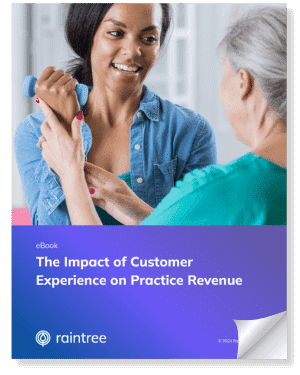If your one-size-fits-all-ages approach to patient engagement isn’t working, and here’s why:
Each generation of your patients—from Boomers to Gen Z—grew up in a different cultural and technological context.
For rehabilitation therapy practices that serve adults, pediatric, or senior patients, it’s imperative to understand the way an awareness of generational trends can make or break your success in patient engagement.
We’ve consolidated the latest research into a list of preferences, priorities, and expectations that define the different age groups. Use these generational trends in patient engagement to fine-tune your practice’s goals, tools, and strategies.
Modern Patient Engagement and Healthcare Consumerism
Today, healthcare organizations are under greater responsibility to ensure that patients are actively educated and involved in their own care. This is, in part, due to the movement from fee-for-service payment models to value-based care. As the name suggests, value-based care favors patients’ values, preferences, and objectives more than ever.
But this clinical shift isn’t the only thing that has changed the way patients use health technology, access healthcare information, and communicate with their providers.
From Patient to Healthcare Consumer
The evolution of the retail and consumer market has slowly but surely made its way to the world of medicine, health, and wellness.
As such, enhancing patient experiences and empowerment requires a strategic embrace or reimagination of consumer innovations: from the rise of online shopping, to remote video conferencing, to video games and virtual and augmented reality, to the social media “Influencer.”
While age is just one factor in consumer and healthcare decisions, the differences across generations can’t be denied.
For example, a high percentage of older generations still prefer to have a designated primary care physician (PCP) orchestrate their overall care, as the idea of a local “family doctor” seems more reliable to them.
On the other hand, patients who grew up during the rise and boom of the Internet era—including Millennials and Gen Z—are more accustomed to online services and interfaces.
A 2021 Healthcare Information and Management Systems Society (HIMSS) report indicates that over 70% of the younger generations would rather see a doctor through telemedicine than book an in-person appointment.
When trying to reach the “patient as consumer,” healthcare leaders, marketers, and providers need to understand decision-drivers across the generations.
Rehab Therapy and Generational Differences
Physical therapy, occupational therapy, and speech-language pathology often require patients to adapt their lifestyle around new exercises or ways of interacting with their day-to-day environment. For these specialties, keeping patients motivated to improve their health is an imperative.
But it’s not that simple, in practice. When your health engagement efforts don’t take patient needs and preferences into account, they’re more likely to fall flat. Different preferences, needs, values, and expectations across the ages will define how patient populations react to healthcare trends and embrace new technologies. Hence the need for a generational approach!
Benefits of a Generational Approach
Personalized, engaging healthcare delivery is a win-win for both you and your patients, as better engagement means better health outcomes and more cost-effective treatment.
Let’s look at some compelling advantages of a generational approach:
- Increased trust and patient satisfaction. When patients feel like their healthcare teams truly understand their needs and perspectives, they’re more likely to feel connected.
- Better adherence to treatment. Higher activation leads to greater participation in exercise routines, lifestyle modifications, and treatment plans.
- Confident healthcare decision-making. Clear and consistent communication with your patient means that they can make informed decisions about their healthcare at every stage, and may feel more comfortable discussing concerns with their clinicians.
- Promoting health literacy. It helps patients understand their conditions and interventions better when communication and educational resources are tailored toward their expectations and needs.
- Driving innovation. Constantly adapting to fulfill patient requirements encourage practices to strive for continual improvement and excellence in care.
Generational Trends in Patient Engagement
Here’s a rundown of how different generations typically approach and manage their healthcare needs:
Silent Generation (Born 1928-1945)
- The Silent Generation is most likely to prefer a traditional healthcare approach, “[relying] on their personal doctors to provide medical care direction,” including referrals to specialists.
- More likely to have long-term relationships with their trusted providers. They are among the most likely generations to make appointments proactively and stick to recommended lifestyle changes.
- As “digital immigrants,” they may not be as tech-savvy as younger healthcare patients, but this generation still values certain technological conveniences. For example, as many as 33% of U.S. Silent Generation adults would select a health provider based on “easy access to my test results” and 32% are motivated by the ability to request prescription refills electronically.
Baby Boomers (Born 1946-1964)
- Boomers will take your guidance and run with it! This generation is most likely to follow their physician’s advice, “no questions asked.”
- Baby Boomers are more comfortable with tech than you’d expect, increasingly adopting tablets and wearable devices. Good news for those practices that use check-in kiosks or stay on the front lines of technological innovation in the field.
- This generation loves convenience—so bring on modern payment options. One study showed that “the total percent of dollars paid by patients ages 65 and older via mobile increased by 75 percent between 2018 and 2019.” Practices should ensure that they offer convenient options like eStatements and other popular patient payment options.
Generation X (Born 1965-1980)
- The “sandwich generation” defies easy categorization. Their needs reflect a blend of preferences, including traditional and modern service methods. In one Insider Intelligence report, 62% of patients aged 42-57 used a mobile health app in the past year, 54% used telehealth for themselves or their dependents, and 36% own a wearable health device.
- Gen Xers juggle intergenerational care. This age group is likely to take on the role of healthcare consumer not only for themselves, but for their parents, children, and dependents as well.
- Patient experiences matter! Unlike their preceding generations, who value long-standing relationships with healthcare systems and providers, members of Generation X “are more likely to switch physicians and hospitals based on their most recent experiences, rather than their overall past experience.”
- They’re the skeptics. Patients in this age range are 48% more likely to distrust their health provider compared to the Boomers, and actively seek out their own health information from multiple avenues: during appointments, online, and via social media.
Gen X is the triple threat in healthcare. We’re coordinating care for our kids, personally dealing with the fun side effects of our own aging and dealing with the health needs of our parents.
Alan Shoebridge, Don't You Forget About Gen X: One Generation's Crucial Role in Healthcare
Millennials (Born 1981-1996)
- The “wellness generation” is tuned in to the future of healthcare. More than any other generation, Millennials report high prioritization of health and wellness attributes like better health, sleep, nutrition, fitness, mindfulness, and appearance.
- Members of this generation embrace a hybrid approach. 63% of millennials are willing to combine both in-person and online healthcare options for convenience and flexibility. They’re motivated by on-demand access to personal health and medical services, like online appointment scheduling.
- Personalization is key to engaging Millennial patients. According to a McKinsey report, “49 percent [of millennials] expressed a strong preference for products, services, or apps that leverage personal data to personalize the consumer experience.”
- Don’t forget parent engagement. Though only “three-in-ten Millennials were [living with a spouse and child] in 2019, compared [to] 46% of Boomers and 70% of Silents” at the same age, that’s still a significant portion of this demographic. Pediatric practices, keep this group in mind! Adult practices, too, may see a higher demand for flexibility, as Millennials juggle careers along with parenthood.
Gen Z (Born 1997-2012)
- The youngest generation is one of the most health-conscious. Reports by the American Heart Association and American Psychiatric Association show that Generation Z highly prioritizes healthy nutrition and regular exercise, and are more likely to seek out mental health and preventative services.
- … But financial barriers get in the way. One 2019 report showed that “Gen Z [are] hit hardest by rising healthcare costs,” and are the most likely to put off appointments (59%) or avoid recommended treatment (63%) due to cost.
- The generation of socially-driven decision-making. With up to 97% of Gen Z consumers using social media as a top source of shopping information, it shouldn’t be a surprise that about half of them also use social platforms to find health info. Social networks include perspectives from friends and family, as well as marketing from trusted brands or “Influencer” accounts.
- Frictionless experiences are the norm. As “digital natives,” this generation is accustomed to technology that seamlessly blurs the line between in-person and digital experiences. As such, a successful “omnichannel” strategy would consider patient engagement across all brand touchpoints.
Read the eBook:
The Impact of Customer Experience on Practice Revenue

Using Technology to Increase Health Engagement
The “information age” has led practices, hospitals and health systems to adopt entirely new tools and workflows for practice management and care delivery. And, as we’ve seen, the rise of digital health has created new expectations of the patient experience across all generations.
Today, the various health technology systems involved in digital patient care and engagement include:
- Electronic health records (EHR) systems
- eReferrals
- Patient portals
- Self-service check-in kiosks
- Two-way communications tools, from email to SMS
- Telehealth or telerehabilitation care
- Remote therapeutic monitoring (RTM)
- eStatements and modern payment processing tools
- Workflow automation software
- Artificial intelligence software
Patient preferences and needs have been a driving force behind many of these developments. When you look at the numbers across all generations, it’s impossible to deny the increasing role of technology in patient engagement outcomes. From Boomers to Gen Z, patients want more modern, convenient, and connected healthcare experiences.
Choosing the Best Patient Engagement Software
To create personalized, engaging experiences at scale, growing practices often rely on patient engagement software to create efficient workflows and improved patient experiences.
Raintree Connect, a patient engagement suite designed specifically for PT, OT, SLP, and multi-specialty practices, is the only communication and engagement tool you’ll ever need. Connect features powerful, specialized tools like embedded telehealth, SMS and email communications, digital lead tracking, automated workflows, configurable templates, and more. Our patient portal ensures patient access to their health information, while enhancing the experience with the option to request or cancel appointments in real time. And that’s just the beginning.
Let’s talk about how your growing, multi-location, or enterprise level practice can fine tune the patient journey and level up your engagement strategy.


